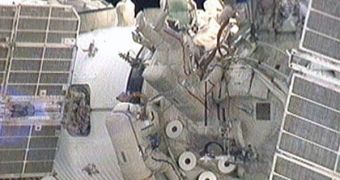Acting ISS Commander Gennedy Padalka and NASA flight engineer Michael Barratt have finished their scheduled spacewalk for the day, as they successfully installed two new antennas, thus priming the International Space Station for the arrival of a new shuttle mission, later this fall. The extra-vehicular activity (EVA) was completed at 8:46 am EDT (12:46 GMT), and the two are now safely back inside the pressurized hull of the orbital facility.
“The spacewalkers installed docking antennas, a docking target and electrical connectors for the Kurs automated rendezvous equipment. Barratt then rode on the end of the Strela boom, a manually operated crane, to take photographs of the antennas. This outfitting of gear was in preparation for the arrival of the Russian Mini-Research Module-2, or MRM2, later this year. The MRM2 will dock automatically to the zenith port of Zvezda and will serve as an additional docking port for Russian vehicles,” NASA announces on its official website.
The astronauts had to delay the beginning of their mission for a little bit because of the telemetry coming to the Russian Flight Control from their brand new Orlan spacesuits. This was the first time the new, improved outfits were tested, during Padalka's seventh spacewalk, and Barratt's first. The two remained in the Pirs docking compartment until 3:52 am EST (0752 GMT), when mission controllers decided that the readings reflected faulty data, and that the levels of carbon dioxide in their suits were well within expected parameters. The two insisted throughout the check that they were feeling fine.
The two, newly installed antennas will help the incoming Mini Research Module 2 accurately calibrate its distance from the various portions of the ISS it has to navigate through before finally docking. As the approach will be fully automated, there is little to no room for error, and the antennas were indispensable for the safety of the entire mission. Work on the new docking compartment will resume on June 10, in another spacewalk, to be held just three days before the STS-127 mission launch to the ISS, delivering the last two components of the Japanese Kibo Research Module.

 14 DAY TRIAL //
14 DAY TRIAL //